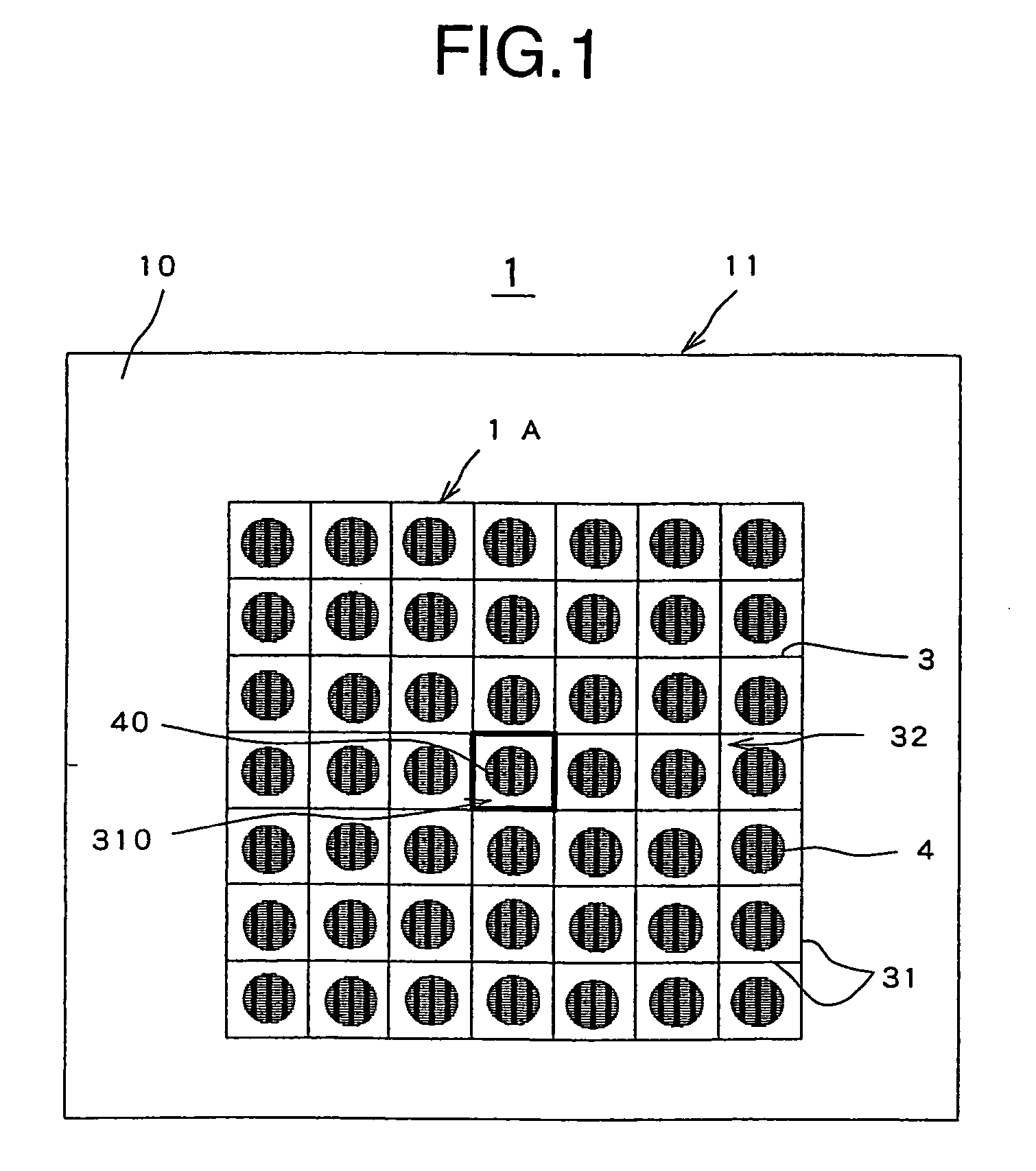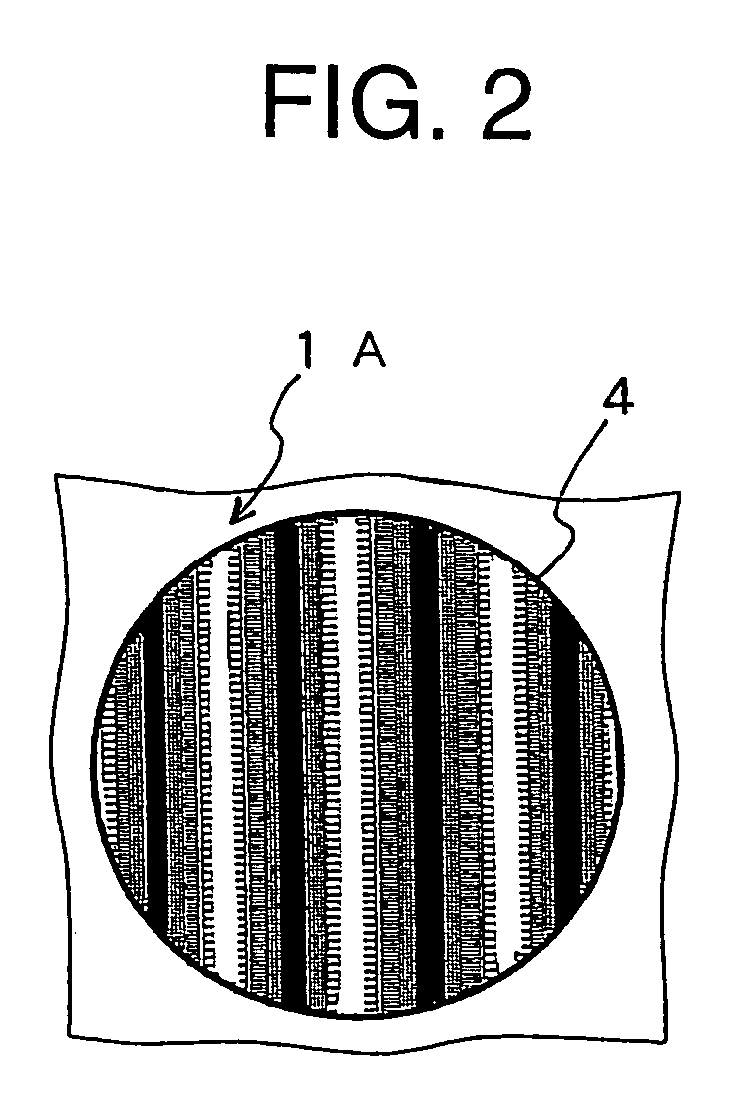[0009]In one preferred embodiment, the visual targets include circular or square targets of two or more kinds of colors different in
hue and complementary to each other. Based on such a figuration, it is checked whether the shapes or profile straight or curved lines can be visually correctly identified, thereby enabling the detection of
visual impairment. Since the colors are different in
hue, it is easy to visually identify the visual targets, and if they are
complementary colors, it will be further easier to visually identify them. Then, it is checked whether the
colored conditions can be visually correctly identified, thereby also enabling the examination of the presence or absence of color defective vision. The visual targets also include circular or square targets divided into four parts in a checkered pattern of a combination of two kinds of colors different from the
background color, or circular or square targets each composed of a vertical striped pattern of two kinds of colors. It is checked whether they can be visually correctly identified to enable the examination of the presence or absence of visual field defects and metamorphopsia. The direction of the striped pattern may be changed to determine the astigmatic direction. In addition, the striped pattern is formed such that one color shifts to the other in a sinusoidal fashion. This makes it easy to detect a
pathological blind spot in the macular area, that is, even in a part where sensitivity is reduced. On the eye test chart, a fixed target having a color or colors different from those of said circular or square targets, or a profile line (grid, etc.) bolder than those of the other targets is also arranged at the center. Then, grid targets composed of a grid of squares in which the circular or square targets are displayed are arranged in parallel around the fixed target in both the longitudinal and transverse directions. Using this chart, it is checked whether there are parts in the chart that look missing or disappear from the eye, whether the grid squares of the grid targets look skewed, and whether the striped pattern or checkered pattern can be visually correctly identified. It allows the examination of the presence or absence of central and paracentral visual field defects and metamorphopsia. Further, enlarged circular or square targets formed by just enlarging the pattern of the circular or square targets arranged inside the grid targets are arranged vertically and horizontally in parallel to enable the detection of a visual field detect even in a person with low
visual acuity.
[0010]In another preferred embodiment, band-shaped targets formed in the shape of a band with a checkered pattern of multiple squares, each composed of the striped pattern or checkered pattern with the four divided parts, are arranged around the central portion of the eye test chart vertically and horizontally in parallel. It allows the detection of a visual field defect in the Bjerrum area. The difference in color, rather than the striped pattern, is used to identify the four-divided squares in the checkered pattern so that the band-shaped targets can be identified even by the eye with low sensitivity. On the eye test chart, a set of blind-point targets for determining Mariotte's
blind spot, composed of a combination of one or more black figures, is also arranged at a predetermined bilateral position, so that the proper positional relation between the chart and the eye can be maintained, thereby carrying out the eye tests easily and accurately. Further, multiple blind-spot
peripheral targets
colored with a color different from the
background color and easy to visually identify are arranged around the blind-spot targets in a bilaterally symmetrical pattern. The use of the blind-spot
peripheral targets makes it possible to check whether the extent of Mariotte's
blind spot is widened. In addition, large-sized square targets, each of which is a black square larger than any other single circular or square target, and which contains two figures
colored with the
background color or a color of high
lightness and spaced at a predetermined interval, are arranged on four corners of the eye test chart. Then, at least two or more parallel square targets, each of which is composed of a hollow figure shaped like a Chinese character “” with the figure parts colored with a color different from the background color and easy to visually identify and the hollow parts colored with the background color, are arranged at both top and bottom sides, or at both right and left sides, in parallel in the transverse or longitudinal direction. Further, at least two or more parallel circular targets, each of which is composed of a hollow figure shaped like a number “0” with the figure parts colored with a color different from the background color and easy to visually identify and the hollow parts colored with the background color, are arranged at both top and bottom sides, or at both right and left sides, in parallel in the transverse or longitudinal direction. The use of these targets different in shape and color enables the examination of the eye's resolution in each
disease region and each stage of the
disease. These targets can also be used to a detect visual field detect or hemianopia, and further a nasal step in
glaucoma.
 Login to View More
Login to View More  Login to View More
Login to View More 


